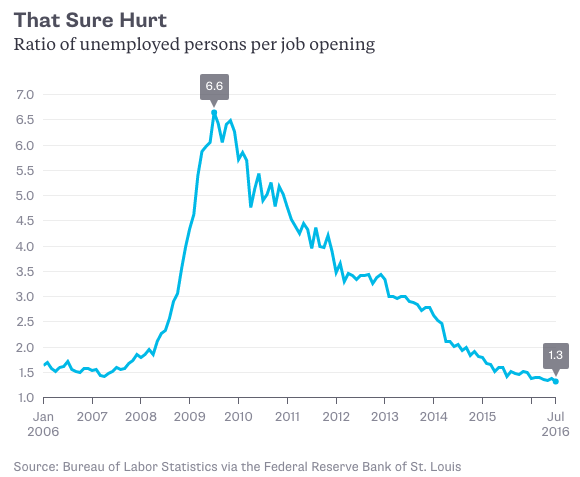Having Trouble Hiring? Try Paying More
Job-market data suggests that employer demand may have caught up with labor supply.
Bloomberg, September 8, 2016
Pop quiz time. Which of the following explains the inability of employers to fill open positions:
- A lack of qualified workers?
- Low pay?
- Welfare state/transfer payments that make work unappealing?
I’ll try to answer that based on my own (admittedly anecdotal and limited) experience.
A few years ago, I was trying to fill an opening in our New York office. I offered what I thought was a competitive salary for a junior position, including good benefits. No one seemed to fit the bill.
I mentioned this to a friend who had a lot more hiring experience. I showed him all the details: Fast-growing company, exciting work environment, lots of perks (window office, unlimited coffee). When it came to pay, he laughed at me. “You are trying to hire someone in a high-paying industry in the most competitive and expensive city in the country for that job,” he said. “Try raising your offer.”
We did, by 50 percent. Suddenly, we had lots of qualified applicants.
I was thinking about this as I read a recent survey of small business owners:
Fifty-three percent reported hiring or trying to hire (down 3 points), but 46 percent reported few or no qualified applicants for the positions they were trying to fill. Fourteen percent of owners cited the difficulty of finding qualified workers as their Single Most Important Business Problem. This issue ranks third out of nine major issues listed. Twenty-six percent of all ownersreported job openings they could not fill in the current period, down 3 points from, the highest reading in this recovery. (emphasis added)
A little more digging into the data might shed some light (and in the process answer the question posed in our pop quiz).
Let’s start by turning to the most recent Bureau of Labor Statistics Job Openings and Labor Turnover Survey, better known as Jolts, which was just updated yesterday. Although the jobs report is better-known, this monthly measure of job openings provides an important piece of the employment puzzle. BLS notes that Jolts gives us “insight into the dynamics of the labor market.” Jolts is often an indicator of employee sentiment — workers usually don’t quit a job unless they are confident that they can quickly find work elsewhere.
But looking at job openings only provides half of the equation; the other half is the number of unemployed who are seeking work. By looking at this ratio, we can get a rough idea of the balance between labor supply and employer demand. When the ratio is high, there is lots of supply and that acts as a natural cap on wage increases. When the ratio is low, it means demand is catching up with supply. That suggests that price increases in the form of wage gains could be in the offing.
The chart below shows the ratio between these two numbers:
This chart is revealing. As of yesterday’s Jolts data, the ratio is closing in on 1 to 1. This is the lowest since January 2001.
I find it difficult to look at this chart and not see both a robust labor market and an increasing likelihood of rising wages. Ed Yardeni, writing before the latest Jolts numbers, observed that “August’s consumer confidence survey found the percentage of respondents who said that jobs are plentiful rose to 26.0%, the highest since August 2007. The percentage saying that jobs are hard to get was 23.4%, near recent cyclical lows.”
All of which raises an interesting question about why there are few signs of pay increases so far.
I have a simple theory about this: Employers are both wary and a little bit spoiled. They are wary because they don’t know how long low interest rates will hold down the cost of capital; many businesses have been prudently running lean, keeping expenses and overhead in check. It isn’t a surprise that we still see lingering signs of post-credit-crisis stress.
They are also a little spoiled, because so many workers were desperate for jobs for so long and weren’t in a position to bargain for higher pay. That period seems to be ending. The low ratio of job seekers to openings suggests that if employers want to hire — and keep their existing employees — they might have to increase wages sooner rather than later.
For the economy as a whole, this is a potentially positive development.
______________
1. For more on the history of Jolts, see “Analyzing the JOLTS Hires and Separations Data.”
2. You can find both of these data — UNEMPLOY (total number of unemployed) andJTSJOL (total nonfarm job openings) — at FRED, the economic data site of the Federal Reserve Bank of St. Louis.
Originally: Having Trouble Hiring? Try Paying More



What's been said:
Discussions found on the web: